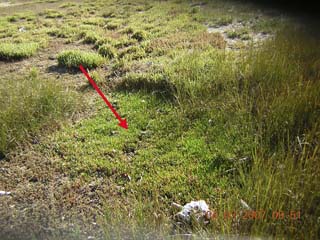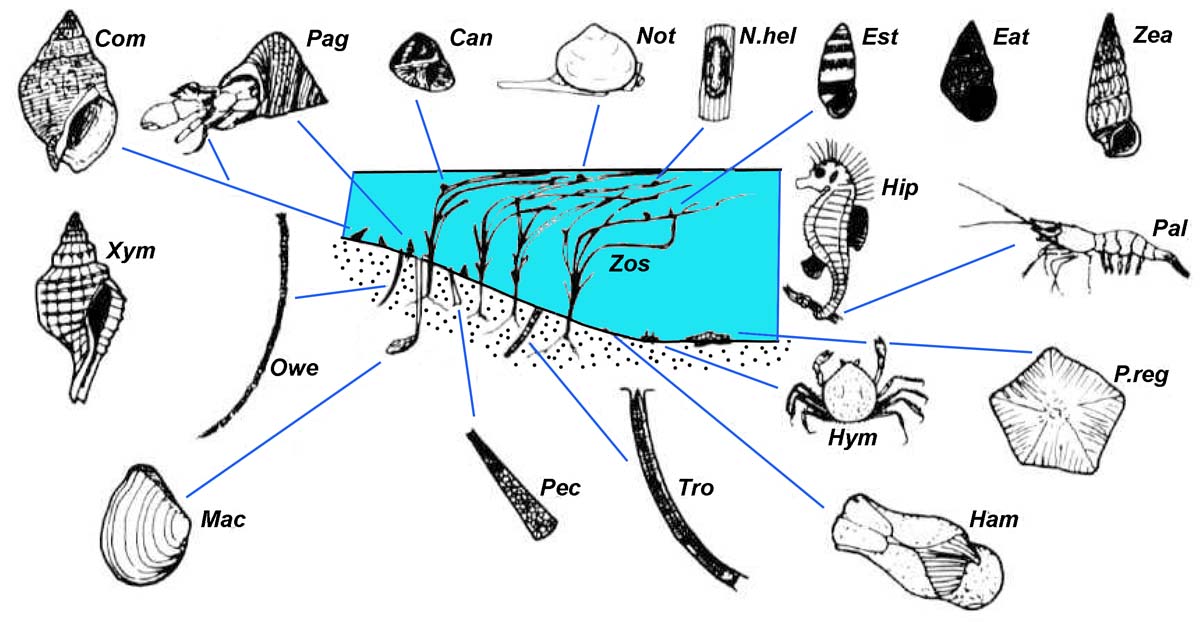
Ngakuta Bay at low tide exposes a large low-lying intertidal area which is rich in plants and animals that are especially adapted for salty conditions. In the foreground is a thick carpet of water pimpernel, Maakoako Samolus repens. Other plants an animals in this fascinating area are illustrated and described below. Wherever possible photos are taken at Ngakuta Bay.
 Water pimpernel, Maakoako Samolus repens. This plant is quite common on the foreshore at Ngakuta Bay. It grows initially as a rosette and then develops prostrate branches. It has a high tolerance to waterlogging and salinity, and is therefore good at colonising salt marshes. Photo Foss Leach, identification Patrick Brownsey Te Papa. Enlarge |
 A patch of water pimpernel during flowering, Xmas day 2008. These flowers are tiny and barely noticeable whn wandering along the foreshore, but stoop down and take a look closer up; it is quite beautiful. Photo Foss Leach. Enlarge |
 Glasswort or Salicornia, Ureure Sarcocornia quinqueflora, formerly Salicornia australis. This slow growing succulent plant is common on salt marshes and there are many patches of it along the foreshore east of the trailer park. They are very tolerant of salt condition including immersion in seawater. The leaves are very small like scales, and give the appearance of being without leaves, a little like some of our alpine Hebe spp. The colour varies from reddish tinges to bright green (next photo). Photo Foss Leach. Enlarge |
 Another patch of bright green Salicornia. The leaves are edible, and as a special treat English fishmongers used to give it away with fish. Cook it in the same way as asparagus (without salt). Three minutes in boiling water will do it, then refresh it in ice-cold water before adding to a dish or eating it as a standalone dish, with a bit of olive oil, or butter, and lemon juice. Of special interest to me is the fact that this plant uses the C4 pathway for photosynthesise and is a useful marker in archaeology. . Photo Foss Leach. Enlarge |
 Native ice-plant, Horokaka, Disphyma australe. This native plant is quite rare at Ngakuta Bay. It has a very small pink flower compared to the more common variety of ice-plant, Carpobrotus edulis, introduced from Sth Africa. The two hydridise. Photo Foss Leach, identification Barry Sneddon Te Papa. Enlarge |
 Jointed wire rush, Oioi, Apodasmia similis, formerly Leptocarpus similis. Found throughout New Zealand in coastal marshlands and estuaries. It spreads slowly from a creeping rhizome. Separate plants have either male or female flowers. Photo Foss Leach, identification Barry Sneddon Te Papa. Enlarge |
 Sea rush, Wiwi, Juncus kraussii subsp. australiensis. This grows readily in damp coastal areas and is the most common rush along the foreshore at Ngakuta Bay, Photo Foss Leach, identification Barry Sneddon Te Papa. Enlarge |
 Native sea celery, Tutae Koau, probably Apium prostratum rather than A. australe/. This plant is widespread in many habitats and is salt tolerant. This native celery is an excellent alternative to the Euopean variety and is easy to grow from seeds or by transplanting. Photo Foss Leach, identification Barry Sneddon Te Papa. Enlarge |
 Orache or Fat-hen, no Maori name Atriplex prostrata. This introduced plant, like most chenopods, is edible when cooked. The more common garden fat-hen which can be a nuisance in vegetable gardens was collected for food when I was a boy. Orcache is common around the margins of saline areas, and the salt marsh at Ngakuta Bay is no exception. Photo Foss Leach, identification Barry Sneddon Te Papa. Enlarge |
 Swamp Weed, Remuremu or Rekoreko Selliera radicans. This small salt tolerant plant forms a tight mat of groundcover with small bright green fleshy leaves and tiny white scented flowers. It grows in damp conditions and is sometimes used for lawns that never need mowing. This patch has Samolus repens in the front of it and Sarcocornia quinquiflora behind it. Photo Foss Leach, identification Barry Sneddon Te Papa. Enlarge |
 Closer view of Selliera radicans. Photo Foss Leach, identification Barry Sneddon Te Papa. Enlarge |
 On the areas exosed at low tide are found numerous bunches of this Red seaweed or algae, commonly known as Agar, Maori name unknown, Gracilaria sordida (syn. chilensis)§4. This species and Pterocladia lucida are hand-gathered along the shorelines of New Zealand for extracting agar which is used for growing bacterial cultures and as a gel in the meat-canning industry. Gracilaria chilensis has also been found to be a preferred food by paua in acquaculture. Photo Foss Leach, identification Jennifer Dalen Te Papa and Wendy Nelson NIWA. §4 Nelson, W.A. 1987. The New Zealand species of Gracilaria Greville (Rhodophyta, Gigartinales), New Zealand Journal of Botany, 25(1): 87-98. Enlarge |
 Sea Lettuce, Karengo (generic), Ulva compressa. There are several plants known as sea lettuce, and there are nearly 100 species in the Ulva genus. The long fronds of this seaweed are actually elongated tubes with walls just one cell thick and dotted with air bladders. It is usually abundant in very shallow water close to shore and thrives from nutrient-rich runoff from the land, especially of dissolved inorganic nitrogen and phosphorus. Like the seaweed species above, Gracilaria chilensis, this seaweed attached itself to a cockle shell for anchorage, and sometimes the two species will be found together on the same shell. The dry powder found in instant cup noodles in Japan is ground up sea-lettuce. Photo Foss Leach, identification Jennifer Dalen Te Papa. Enlarge |
 Eel-grass or Sea-grass or Zostera, Rimurehia, Zostera capricorni. This marine perennial flowering plant carried out its entire life cycle under water. It grows by budding stems and leaves from a creeping root system and entire bed can consist of only one interconnected plant. This repeated clonal growth pattern means that any one plant can live to great age. A single clone of the European species Zostera marina has been dated at 3,000 years using molecular techniques (Borum. et al. 2004: 26§1). Photo Foss Leach. §1Borum,J., Duarte,C.M., Krause-Jensen, D., and Greve, T.M. 2004. European seagrasses: an introduction to monitoring and management. ISBN: 87-89143-21-3 Enlarge |
 A closer view of eel-grass. This plant plays an important multipurpose role in the ecology of Ngakuta Bay, and as with many parts of New Zealand is in danger from high sediment loads from run-off and polution. These beds have the effect of trapping and stabilising bottom sediments, and provide the habitat for a wide variety of plant and animal species, including invertebrates, fish and birds. This entrapment of fine particles directly improves water clarity in the Bay and thus enhances the environment for other aquatic plants such as algae and also plankton. Photo Foss Leach. Enlarge |
 An aerial view of the foreshoire of Ngakuta Bay showing the present extent of patches of eel-grass. Last year's winter storm greatly reduced the size of eel-grass beds in the bay. These beds are important nurseries for juvenile fish, and deserve a protective approach when walking over the exposed flats at low tide. Enlarge |









